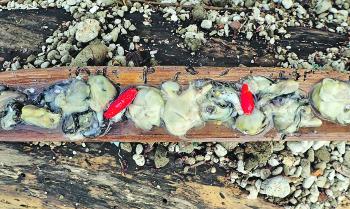As the chilly southerly winds hiss their way up the East Coast of Queensland, let’s take a look at some of the spots and fish species that are still hot-to-trot. Over-simplified, the East Coast bluewater scene will be challenging at best and West Coast inshore season should be spectacular.
The prevailing wind throughout the dry season will be from the southeast, making the Gulf of Carpentaria coast a pleasure to fish with the winds blowing offshore. Inshore bait schools will settle very close to the coastline and sports fishos will be targeting the pelagic species that tear through densely packed sardines, anchovies and hardiheads.
Toothy predators such as grey, Spanish, school and broad-barred mackerel can all be caught very close inshore this time of year. Anyone should be able to cruise up and down the West Coast a few kilometres from shore and find dipping gulls, circling frigates and plunging booby birds without too much trouble.
Giant trevally and large queenfish may be found even closer in again, attacking the densely packed balls of bait, often within a few hundred metres of the coast. Joining them will be veracious little steelback salmon, blue salmon, golden trevally, giant herring and wolf herring. All these speedsters will keep anglers using a variety of metal slices, jigs, plastics and flies, busy for hours.
Any good shows of baitfish on the sounder should be inspected by dropping down something that flutters and zipping it back up to the boat. Expect to get bitten off by smaller mackerel on occasion and to lose the odd decent fish to sharks, which are alerted to the frantic activity. If you begin losing fish to sharks, it is best to stop feeding them and move on to a new area.
Further offshore, those trolling larger lures and wogged garfish can expect some exceptional mackerel fishing around isolated lumps, shoals and contour lines. Remember to mark any hook-ups so effort can be concentrated on that location. Mackerel may sit adjacent to current and structure throughout a tidal run so leaving fish on the bite to continue elsewhere is a mistake.
Stingrays and manta rays shovelling their way down the West Coast may be followed by small cobia and golden trevally this time of year. Casting almost any lively presentation behind these graceful beasts can lead to fantastic visual hook ups. The water is generally very clear near the creek and river mouths on the West Coast throughout July. Casting flies and sighting fish before making a presentation is a very addictive form of fishing.
Switching over to the East Coast, anglers will have the most success in the creeks and rivers and sometimes the shallow inshore shoals this time of year. The big boat brigade will be getting hoarse throats from complaining about the persistent trade winds, wishing they owned a little punt instead. They should be getting right up some of the tight East Coast creeks to battle the mangrove, junction and sand-spit dwellers.
Small estuary and rivers systems fed by some of the larger wetlands and salt marshes during the rainy season will by now have discarded most of their tiny crustaceans and baitfish. Many of these systems will continue to fish very well into July, remaining nutritiously supercharged.
Mangrove jack, cod, smaller GTs and Papuan trevally, tarpon and barramundi can be thick on the neap tides where deeper holes and structure combine on a gently receding tide. Shallow divers and small weed-guarded soft plastics are a dynamite way to fish some of these snaggy bends and a small punt or on foot are the best way to sneak up on them. Enjoy searching in July until you find that pot of honey where the fish are holed up for the winter. They still have to eat!
• For information on remote charter operations for tailored fishing adventures, please email Tim on --e-mail address hidden--
Reads: 2382

A nice barra ready to leap from a brackish East Coast creek. 
A couple of fish landed from an isolated rock bar. 
Hooked up solid on a remote island cay. 
Succulent milky oysters with vinegar and chilly eaten fresh. Matched Content ... powered by GoogleLatest Articles

Most Popular |
|---|



